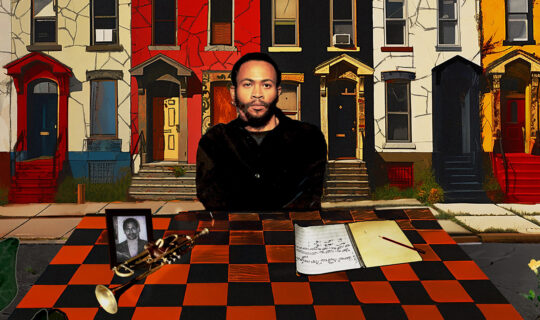February 17, 2013
In an era dominated by the glossy veneer of “Facebook blue,” Kenny Burrell‘s Midnight Blue sets the mood for a brief return to a bygone era when the deep indigo of the Yves Klein version was more common. Darker hues ruled the night, and the pale moonlight of a lovelorn skyline meant it was past last call and all that remained of the day was an overwhelming air of what could only be called the blues. “The blues,” Duke Ellington wrote, “the blues ain’t nothin’ but a cold gray day, and all night long it stays that way…the blues is a one-way ticket from your love to nowhere; the blues ain’t nothin’ but a black crepe veil, ready to wear.”
Leonard Feather begins his liner notes for Burrell’s seminal album with this quote, invoking one of the consummate jazz guitarist’s greatest influences, and one of his greatest champions. Now 81, Burrell even teaches a course on Ellington at UCLA. Part Lawrence Lucie, part Charlie Christian, he has a steely, cool-under-pressure sound on the guitar that dovetailed perfectly with Blue Note’s prevailing blues-infused character.
Few albums capture the aesthetic of Blue Note’s golden era better than Midnight Blue—a consistent set of original minor grooves meant to be experienced in its entirety, rather than padding for one standout track—and it justifiably occupies a place in the jazz canon, a common entry on countless essential listening lists. Recorded 50 years ago at Van Gelder studio in Englewood Cliffs with Burrell’s pianoless quintet, the album still holds up to critical scrutiny, or to a pairing with a half-empty bottle of Scotch. Undoubtedly, 1963 was a high-water mark for jazz, in New Jersey and elsewhere.
One of Burrell’s most enduring achievements, the album plumbs the depths of the blues for its harmonic subtleties and lyricism in a manner that can be readily accessible on its face yet challenging enough to reward repeated visits. As always with Burrell, though, never mistake brevity for simplicity; the fathomless 12-bar mantra has no two identical choruses, and Burrell doesn’t rely on reflexive facility, the blues equivalent of fool’s gold.
A true master, Burrell has internalized the form, giving him the sense of repose and restraint that is the cornerstone of any bluesman worth his salt. On this outing, he is joined by like-minded players who create the illusion of a loose blowing session within a tight framework: tenor saxophonist Stanley Turrentine, bassist Major Holley, drummer Billy Gene English, and conguero Ray Barretto, a highly regarded bandleader in his own right who injects a dash of Latin flavor into the mix.
Burrell got his start as a Detroit rhythm guitarist; as a result, his time is unerring and right in the pocket, he always spells out the chords and forecasts where he’s going, but like a great bus driver, he doesn’t draw attention to the underlying mechanics. The effect is a listener-friendly album with a tonally nuanced atmosphere easily shared between the jazz aficionado and the neophyte who just heard Kind of Blue for the first time; regardless of background, a smooth ride allows passengers to take in the scenic vistas.
The album opens with Burrell’s classic minor blues, “Chitlins con Carne.” Often covered by artists ranging from Horace Silver to Stevie Ray Vaughan, this is the low-key original that set the standard for this now standard Latin-tinged blues. The eight-bar intro lays down a pulsing Latin clave, with Holley pedaling the bass as Barretto takes liberties on the congas. Turrentine’s matter-of-fact statement of the melody establishes his by turns lugubrious and diaphanous sound.
Burrell’s sparse comping sets the album’s precedent for succinctness, one of his hallmarks. His deceptively clean guitar solo walks a tightrope between endless space and airtight rhythmic motifs; a devil-may-care attitude in the face of death that comes from having been down and out and having lived to tell about it. Turrentine plays foil, Captain Kirk to Burrell’s Spock, singing the blues right out of the gate, but the two show their psychic connection when seamlessly trading not fours, but ones, until the blistering out chorus.
“Mule” recalls Howlin’ Wolf sideman Hubert Sumlin‘s feel and precision, a slow-marinating, soft blues that the band works over like a bomb squad that has seen it all. Unlike other jazz subgenres, the key to the blues is to never let the bomb go off, and the five demonstrate an unwavering focus, keenly aware of this urgent fact. Punctuated by Holley’s downward bass slide riff and English’s ambling hi-hat, Turrentine and Burrell stretch out on this quintessential slow jam.
Burrell keeps it mellow on the crepuscular “Soul Lament,” a solo minor groove that departs from the blues form but nevertheless retains its spirit. Though under three minutes, this represents some of Burrell’s most sensitive playing, replete with embellishments, a rhythmic elasticity, and complex inversions. The pace picks up abruptly on the title track, which reintroduces the rhythm section, but not Turrentine. Taking another departure from the 12-bar blues, Burrell shows his prodigious bebop chops here, cutting loose on some extended lines juxtaposed with subtler rhythm guitar, employing technique that carries his characteristic fullness despite its comparatively fewer notes.
Turrentine returns on “Wavy Gravy,” a smoldering mid-tempo blues waltz that brings the minor groove to a new tension point. Holley establishes the groove with a well-articulated bass line, which Burrell glides over sparsely, until the saxophonist comes in to state the head in unison with the guitar. Turrentine’s and Burrell’s solos are the epitome of cool, a relaxed but structured call-and-response that typifies the album’s eponymous color.
“Gee Baby, Ain’t I Good to You,” the album’s sole non-original, is a lazy, schmaltz-free meditation on love. Burrell uses it as a springboard for his effortless, behind-the-beat bebop phrasing, playing off English’s sultry brushwork. Burrell closes the album with “Saturday Night Blues,” a driving nightcap to a bottomless evening that shifts the blues from minor to major. Turrentine simply wails; his style contrasts perfectly with Burrell’s cavalier detachment. The two continue riffing over each other until it all starts to fade out—the blues are never finished, merely abandoned at dawn—as Saturday night palpably fades into Sunday morning.




